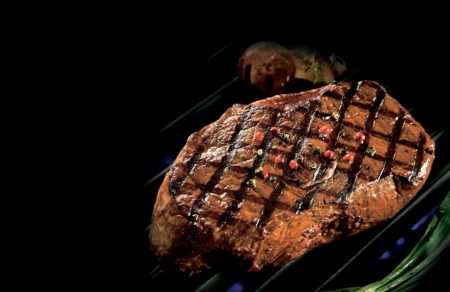There is a culinary law: the less the steak is roasted, the juicier and tastier it will turn out. That is why medium-rare is recommended for high-quality beef with pronounced marbling. In this article, we’ll share professional tips and proven recipes on how to make a Medium Rare Steak in your home kitchen.

- To begin with, the classic steak is made from aged beef, which has a layer of fat. Moreover, the higher the marbling of the meat, the higher the degree of its roasting can be. Accordingly, if there are few fat layers in the meat, it is better to cook it quickly, choosing the degree of roasting no higher than medium.
- A medium-rare steak is not raw meat, as some people think of it. This is a properly cooked steak with a soft pink core inside and an abundance of red juice. Those who call such a steak “meat with blood” do not know that the red liquid is meat juice. Just under the influence of temperature, the protein myoglobin stains it in a reddish tint.
- The classic boneless marbled beef steak is fried for 2-3 minutes on both sides. Add to this time another 20 minutes for the steak to heat, and another 5 minutes for the steak to “rest” after cooking.
- Most chefs recommend taking steaks from marbled meat, at least 2 cm thick, optimally 2.5 cm. It is believed that this height will not allow the cut to dry out in a pan or grill. Most of the recommendations on how much to fry a medium-rare steak are based on the assumption that the steak is 2.5 cm thick. Fast frying for 4 minutes in a pan instantly seals the meat with a crust, but at the same time, it has time to warm up from the inside. The beefsteak turns out to be juicy, not overdried, and appetizing in appearance.
- Our tip: By lengthening the cooking time of the steak, increase the rest time as well. Use the versatile formula by dividing the cooking time in half – this is how much the finished meat will need to evenly distribute the juices.
- With a well-heated skillet, cook steaks 2–2.5 cm thick for a couple of minutes on each side. Steaks 4 cm thick – 6 minutes in total, and cuts over 4 cm – 8 minutes. The medium-rare roast has an internal temperature of 54-55 degrees. Another couple of degrees, the meat “picks up” when it is resting. Fully cooked medium-rare steaks have an internal temperature of 57 degrees.
- To prepare a classic beef steak, we recommend buying Ribeye marbled beef. Use chilled meats that are moist or dry. It is better to refuse frozen. If there are no options, take blast-frozen meat. With this method of freezing, it retains the maximum useful properties and its excellent taste.
- This is a very important point. Observe it if you want to get a juicy medium-rare beef steak. By allowing the meat to catch its breath, you will give it time to distribute the meat juices, which accumulate in one place during the frying process. The average “rest” time is 3-5 minutes. It is better to keep the meat under foil so that there is no sudden temperature drop.

